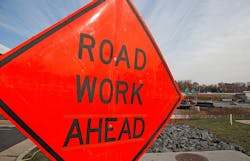A new study indicates that vehicle operators and passengers are more likely to be killed or injured in highway work zone crashes versus workers in those construction zones – with speeding the major cause of vehicles crashes in highway work zones.
According to the Associated General Contractors of America (AGCA), out of the 400 highway contractors the group surveyed coast to coast, 43% said motor vehicle operators or passengers suffered injuries in work zone crashes in 2013, with 16% of them killed in such crashes. And while work zone crashes are less likely to kill construction workers, AGCA’s research found that more than 20% of such accidents injure workers in those areas, with 6% of those crashes killing them.
Similar data from the National Highway Traffic Safety Administration (NHTSA) adds weight to AGCA’s findings, as the agency said 609 people died and 32,000 were injured in highway work-zone crashes in 2012, an increase of 19 fatalities over 2011. As some 130 of those 609 fatalities were highway workers that means nearly four in five victims in 2012 work zone crashes were motor vehicle drivers or passengers. Also, 132 fatal work zone crashes involved large trucks and buses, NHTSA noted.
“There is little margin for error when you work within a few inches of thousands of fast-moving vehicles,” noted Tom Case, the chair of the AGCA’s national highway and transportation division and senior vice president of Granite Construction, in a statement. “As the data makes clear, not enough drivers are slowing down and staying alert near work sites.”
"The latest statistics show that speeding was a factor in more than 35% of all fatal work-zone crashes in 2012," added Bud Wright, executive director of the American Association of State Highway and Transportation Officials (AASHTO) in a related statement. "Drivers must understand why they need to slow down and pay attention, especially now. This is the start of the roadway construction season and thousands of workers are going to be out there, on America's highways and bridges."
Work zone crashes also have a pronounced impact on construction schedules and costs, AGCA’s Case pointed out, noting that 25% of contractors reported that work zone crashes during the past year have forced them to temporarily shut down construction activity. Those delays were often lengthy, as 38% of those project shutdowns lasted two or more days.
The group is releasing the results of its highway work zone crash study to coincide with National Work Zone Awareness Week, which began April 7 and concludes April 11.
Virginia Transportation Secretary Aubrey Layne noted that in 203 Virginia recorded 21 fatalities in work zone crashes and stressed that drivers need to understand that traveling at high speeds means vehicles can come upon highway work zone much too fast to stop.
“Recognize when you’re approaching a highway work area and react appropriately to the warning signs and traffic flow,” Lane noted in a statement, pointing to several helpful tips drafted by the Virginia Department of Transportation (VDOT) to help drivers of all types of vehicles safely navigate highway work zones:
- Follow the signs: Signs and flaggers will direct you through the work zone. Expect changes in traffic patterns as the project progresses.
- Don’t tailgate: Unexpected stops frequently occur in work zones.
- Don’t speed: Enhanced fines of up to $500 may be levied for speeding in a work zone.
- Focus: Focus your full attention on the road and those traveling around you.
- Never change lanes in the work zone.
- Minimize distractions: Avoid changing radio stations and using phones.
- Expect the unexpected: Keep an eye out for workers and equipment.
- Be patient: Remember, crewmembers are working to improve the highway, and the safety and comfort of your future travels.
“Motorists need to slow down and take caution when driving through work zones,” said Bryan Wold a driver for Con-way Freight and America's Road Team representative, in a statement.
“Reducing speed, paying attention and keeping a safe distance from other motorists and workers will help move everyone through the construction areas safely,” he noted.
About the Author
Sean Kilcarr
Editor in Chief
Sean Kilcarr is a former longtime FleetOwner senior editor who wrote for the publication from 2000 to 2018. He served as editor-in-chief from 2017 to 2018.
